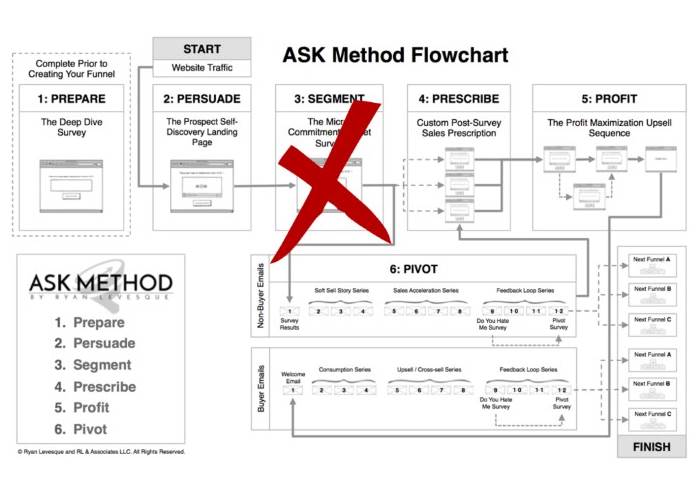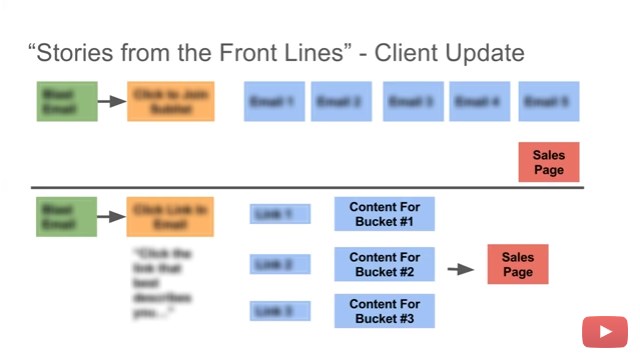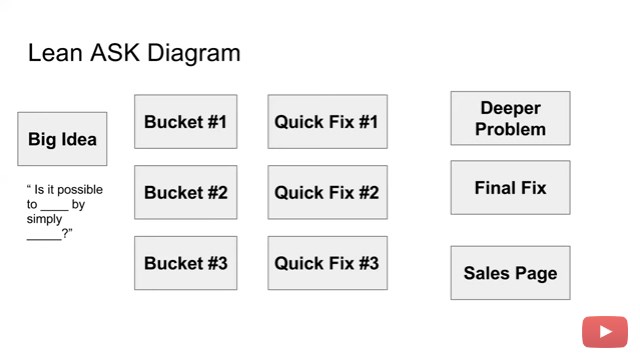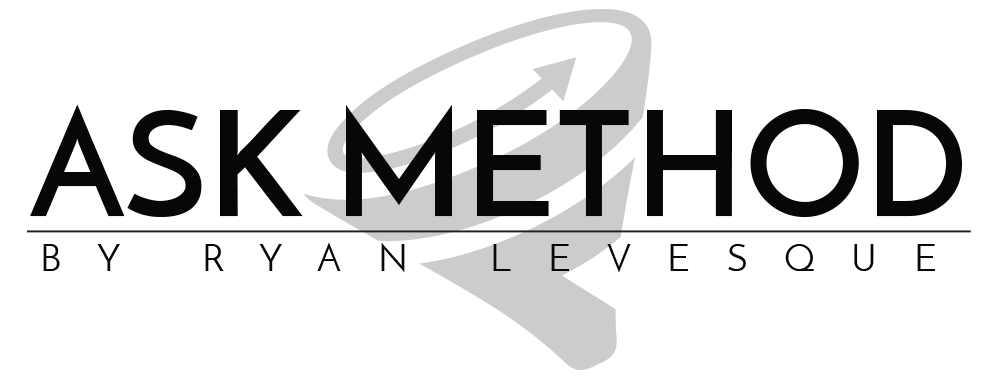This man is REALLY good at building sales funnels.
His name is Ryan Levesque.
He’s so good at it that savvy business owners far and wide get a little breathless when they imagine getting themselves into the same room as him.
They DREAM about hiring him to revamp their sales funnel and put another zero or two on their monthly income statement.
Maybe you do too.
Unfortunately, unless you have very deep pockets, Mr. Levesque is a hard man to get access to these days.
That’s because he’s generally too busy teaching his increasingly-popular quiz-based approach to marketing to directly lend a hand when it comes to building his unique style of sales funnel for others.
What does this mean for you?
Just that if you want an ASK-style sales funnel of your own, you’re probably going to have to build it yourself…
Is that you?
Have you recently taken to drinking the Ryan Levesque kool-aid?
Are you now utterly convinced that the future well-being of your company or your passion project is inextricably tied to your ability to successfully implement an ASK methodology sales funnel?
If you are, then you’re in luck.
Because I wrote this article with the express goal of attracting one very specific type of masochist.
One for which I suspect you, dear reader, may harbor an uncomfortable affinity…
So You’re Fixated On The Idea Of An ASK-Style Sales Funnel – Now What?
Masochist.
There’s no other word for it.
Well, maybe one… nuts.
You have to be just a little bit nuts for wanting to do something like this.
If you’ve already ponied up thousands of dollars to attend Ryan Levesque’s ASK Masterclass, like I have, then you know what I’m talking about.
Because you know that building an ASK-style sales funnel is hard work.
Really hard work.
Ryan admits as much.
In fact he seems to take a great deal of satisfaction from the idea.
The way he tells it, the surplus of blood, sweat and tears you’ll be required to provide to build your ASK method sales funnel will furnish you with an incredible advantage over your competitors.
Because despite wanting to succeed like you do, they simply won’t be prepared to go to the lengths that you are prepared to go.
The dude has a point.
For someone new to the notion of going all in on your level of commitment as a marketer this ASK stuff can seem like some awefully scary sh*t.
Let me tell you why I think so, and how you can survive it anyway.
Oh, Mr. Levesque… Oh, Hell No!
The first time I got a look at Ryan Levesque’s approach to building a profitable sales funnel I threw my hands high into the air and said “Not for me!”
But it didn’t start out that way.
In the summer of 2014 I purchased Ryan’s sales funnel course, which he called the Survey Funnel Formula.
This was his first attempt to teach the method he’d used successfully for several years to sell online products to total strangers using what appeared to be little more than the sales synergy that results from combining quizzes with paid advertising.
Right from the get-go it seemed an incredibly appealing answer to that most important of marketing questions:
How do I make more people want to buy more of my stuff?
Today his ASK Masterclass is the more evolved version of this offering, but it is nonetheless the same program.
I signed up to learn the original version of the system based on the idea that I could offer the same funnel building and copy writing services that were needed to launch such a funnel.
But when I saw everything that was involved I decided it was just too damn complicated and I abandoned my plan.
Here’s what was going through my head at the time.
On the surface, the notion of being able to figure out the wants, needs, and frustrations of your ideal prospects by using simple quizzes to obtain the information seems like a no-brainer.
You literally get to read the minds of your prospective customers and parrot back to them the exact words they need to hear to be convinced that you get them and are totally dialed into their world.
It represents a complete abandonment of the “one size fits all” approach to imprinting your sales message on your market.
If there is a better way to get prospects to know, like and trust you – all required precursors to getting them to BUY from you – then what could it be?
So – I’m a smart guy – all I needed to do was learn the system and then do what Ryan had been doing.
Surely I could do that.
As it turned out… not so much.
Once I had properly surveyed all of the separate components that go into making a fully-fledged sales funnel – from landing pages, to quizzes, to email autoresponder sequences, to sales pages and upsells… plus all of the copy requirements and the technical know-how needed to piece it together – I was simply overwhelmed.
The skill set required to do it all seemed almost too much for any one person to handle alone.
Complete fricken downer.
Looking back, I realize now that my plan failed for a reason that, perhaps if I had only understood it back then, need not have derailed me the way it did.
Let me tell you now what I’ve figured out in the time since then…
If you are feeling similarly stressed at the prospect of putting together a complete ASK sales funnel, the following may prove to be of some use and comfort in deciding how to proceed.
How To Survive Building Your First ASK Sales Funnel (Part 1)
To get where we need to go, allow me to first dial the clock back a little.
That way we can see how it is we got to where we are now – which is running around like a bunch of headless ASK chickens squawking about how this is all just a bit too much to deal with…
Historically the origin of the ASK method can be traced back to early 2008 and Ryan’s initial dabbling in an info-product business in the Scrabble-tile jewelry-making market.

From small beginnings. ASK, circa 2008, starts with sales of a tutorial on how to make your own Scrabble-tile jewelry…
This was where he made the discovery that not all his prospects were interested in achieving the same goal.
To reach them on the core emotional level needed to compel them to buy he found that he had to segment both his audience and his sales message, and match the correct audience to the correct message.
From this realization arose the somewhat vague concept of “buckets” – segmented audiences, each of which require their own custom messaging.
Why do I say vague?
Because despite his short-lived but promising success in the Scrabble-tile jewelry niche (it turned out to be a bubble market) Ryan wasn’t able to initially duplicate his success.
Before the Scrabble-tile jewelry market collapsed, he and his wife Tylene had been able to increase the income level of the business to a respectable $10K/month.
But when Ryan launched his next info-product business, one based on selling an ebook on the subject of orchid care, he did not make a SINGLE sale.
Imagine how he must have felt breaking that news to his wife…
Despite the insight gained from selling to the Scrabble-tile jewelry market about the importance of querying your prospects before deciding what it is they are likely to buy from you (a process of querying that has since become known as the deep dive survey) somehow he had completely missed the mark.
It was his first BIG lesson in what can go wrong when you don’t have a firm grasp on what you need to focus on when analyzing your response data.
It wasn’t until he figured out that only the hyper responsive responders to his request for information were worth paying attention to that he struck gold.

Pot of gold. From zero to $25K/month within 18 months. The first business based firmly on the ASK method involved selling an ebook on orchid care.
Finally he was able to properly segment his audience and provide them with the appropriate messaging.
After that the ebook sales began to pour in like clockwork.
Most importantly, he had unearthed a reliable and repeatable approach (using the deep dive survey) to figuring out how to successfully market to any well-defined group of consumers.
Both the orchid care business and the memory-improvement business that followed it benefited from this “bucketing” approach.
Both businesses were able to consistently convert cold traffic (total strangers gathered with paid ads) into paying customers.
They achieved this by following up with ongoing customized marketing messages delivered via an email auto responder to the relevant segmented audience.
Indeed, this is the PRIMARY OBJECTIVE of an ASK method funnel:
- First we figure out the relevant bucket into which a visitor should be placed.
- Then we capture that information along with their email address to our auto responder.
- Finally we communicate with them in the appropriate bucket-specific way.
By the time Ryan offered his Survey Funnel Formula course he had developed an elaborate way to perform this bucket determination.
The visitor is asked an automated series of carefully devised questions – perhaps up to half a dozen questions.
He calls it the micro-commitment bucket survey (or MCBS).
It forms the basis of the ASK method of lead collection for cold traffic.
But in the early implementations of ASK – the orchid care business, the memory-improvement business – the seemingly critical micro-commitment bucket survey is not present…
That means the funnel flow more or less looks like this (an ASK diagram you’re likely familiar with, except now we have struck out the MCBS):

The email opt-in and segmentation stage is still there, but it is vastly simplified now that the quiz component has been removed.
I failed to pick up on this rather important simplification when I went through Ryan’s program the first time.
Both the orchid care and memory-improvement ASK funnels use this simplified approach.
Here’s why this matters so much if you are having trouble trying to find solid ground in ASK land…
How To Survive Building Your First ASK Sales Funnel (Part 2)
As I said, when I got a good look at everything that went into the full-fledged version of an ASK-style sales funnel I felt as though my brain might melt if I attempted to build one.
Never mind for a client.
I couldn’t even imagine going through the process just to learn the ropes.
So how had Ryan been able to do it?
Well of course he hadn’t.
By the time his Survey Funnel Formula course rolled out and the micro-commitment bucket survey (or segmentation quiz, as it is often called) had been integrated into the flow Ryan had built himself a team to help with the funnel construction.
Long before that, back when he was building the non-MCBS versions of the ASK funnel in the orchid care and memory-improvement markets he had been able to get by with the help of a single employee.
So even then he’d had help.
But anyone who is handed the ASK funnel flow diagram today – especially the full-fledged version that includes the segmentation quiz – and has to contemplate it without the mental safety net afforded them by an ASK-trained team that they can lean upon for help?
Acute brain hemorrhage.
So let’s just say I would not have been completely shocked had I learned I wasn’t the only Survey Funnel Formula customer in 2014 to put it all on the back-burner and try to find something easier to do with my life than to wrestle with ASK-style sales funnels.
Even so, I never gave up completely on the idea.
And when ASK, the book came out in the spring of 2015 I immediately ordered my copy and studied it.
Maybe I’d find some new insight that would make the whole process look manageable again.
Nope. Nothing.
But in hindsight, Ryan’s warning about the danger of potentially coming unglued on the segmentation part of the process did perhaps suggest a growing concern in his mind that the complexity of the system was proving to be a real drawback for newcomers:
I’ve seen what happens when marketing segmentation projects are overly ambitious. The complexity kills the project before it gets off the ground.
Ryan Levesque [Ask. pg 98-99]
At the time he may only have been thinking about the technical implementation of the quiz that forms the basis of his sales funnel for cold traffic.
But after the ASK Masterclass launched in 2016 it became clear that the thinking behind the approach to building one’s first ASK-style funnel had also changed.
The issue of the steep learning curve demanded of an ASK student was finally addressed.
Today, rather than encourage ASK Masterclass students to build a funnel with a functioning micro-commitment bucket survey, when it makes sense and is possible to do so, the SIMPLER (non-MCBS) version of the funnel is advocated for getting one’s feet wet.
This is called the SIMPLE SEGMENTATION funnel.
How Simple Segmentation Saved The ASK Method From It’s Own Undoing…
It’s hard to be revolutionary when no one can understand how to get started with your revolution.
This must cause Mr. Levesque a great deal of lost sleep.
It would me if I was trying to bring about a sea change in online marketing practice.
Because if someone else figures out how to simplify the ASK process and make it more palatable, it will be they who are ultimately remembered for the marketing breakthrough, and not the guy with the original idea.
Or even the process itself will fade from memory if it can be replaced with a simpler alternative.
And this is what makes simple segmentation so important.
It may not just rescue YOUR business, it may also shore up the foundations of the ASK method long enough for it to get the amount of traction in the world it deserves.
So how does it work – this approach to segmentation simplification?
You’ll recall that the purpose of the deep dive survey is to determine the buckets into which the majority – roughly 80 percent – of our market naturally fall.
This is a gross analysis of the general composition of the market.
The purpose of the segmentation quiz is to figure out which bucket best describes any given individual that comes our way.
Depending on the nature of the buckets and the self-awareness of the individual as it relates to those buckets, the quiz could be simple or it could be complex.
Let’s consider an example in the dating and attraction niche.
If I have absolutely no idea (low self-awareness) why it is that I never secure a second date in my quest for romance, odds are that you are going to need to ask me a series of questions about what I do on those first dates before you can prescribe an approach that might help me to finally get that second date.
That would be the ideal approach – but an involved segmentation quiz like this might just derail us because of the complexity and cost of setting it up.
Let’s consider an alternate that does away with the quiz.
Suppose I know, based on the results of my deep dive survey, that there are FIVE main buckets into which first-date sad sacks tend to fall.
Let’s say those buckets are characterized by the following attributes, all of which have readily implementable fixes if we just know what is the underlying problem:
- Abnormally LOW self confidence – It is hard to form an emotional bond, especially a romantic one, with somebody whose spirits forever need to be buoyed.
- Abnormally HIGH self confidence – It is likewise hard to find common ground with someone who constantly needs to be excused for expressing a higher opinion of themselves than of us.
- Low charisma – Successful romance involves selling your personality to the other party, and you’ll never make the sale by being boring.
- Excessive negativity – No one likes the proverbial Negative Nelly who can find nothing to be optimistic about in their own lives, or yours.
- Poor self presentation – Hygiene, wardrobe, grooming. Sometimes it’s the outward package that makes the final damning impression.
Ideally I’d like to ask you a series of questions and figure out from the answers you provide what your bucket is.
If I’m smart about it I’ll be able to determine the bucket more accurately than you would – especially if you have only the poorest sense of what your main issue might be when going on that first date.
But if I’m prepared to forgo the time and expense required to build an intelligent self-diagnosing here’s-the-bucket-you-belong-to kind of quiz that characterizes the micro-commitment bucket survey maybe I can do almost as well.
Maybe I can get away with assuming that my prospects are self-aware enough that I can ASK them directly what bucket they identify with most strongly and this will yield segmentation results that are almost as good as if I’d gone with a full quiz.
And sometimes this is going to work out just fine.
The orchid care and the memory-improvement examples, where only simple segmentation was used, testify to this.
Instead of the quiz I might segment my romantic losers based on the following question and its multiple choice options (buckets):
Given that you know you must be doing something wrong on those first dates, which one of the following characterizations do you think BEST describes your main obstacle to getting a second date?
- I feel I’m lacking the level of self confidence needed to make a favorable first impression.
- I’ve been told I come off as too cocky at times, and it’s true – I’m no wallflower.
- I find it difficult to maintain the attention of others and keep the conversation flowing.
- I sometimes express considerable skepticism which could make me seem overtly pessimistic.
- I pay no attention to what I see in the mirror – wardrobe, grooming – I don’t think it should matter…
Note that whether or not the prospect is correct in their self-assessment is of less importance to us than whether they believe they have correctly identified their main problem.
That’s because the more strongly they identify with their chosen bucket, the more strongly they will pay attention to what we have to say about how someone in that particular bucket can work their way out of it.
Simple segmentation works by eliminating the full quiz and replacing it with a SINGLE multiple-choice question.
It is followed by a call to action button that puts up an opt-in form so the prospect can receive in their email inbox the promised ebook, video, or otherwise-formatted lead magnet that incentivized them to fill out the form in the first place.
It is the specificity of that opt-in question that makes the process so valuable to the prospect because it allows us to suggest that we can use the provided information to further put their issue into perspective and offer detailed advice about what their next move should be.
This is basically the same outcome as if a full micro-commitment bucket survey was used.
The chief difference being that, with simple segmentation, we now have less information about the prospect’s unique situation than we otherwise might have.
No demographic details, and no extra hints as to the full severity of the problem that brought them to our page.
So we’re limited in the extent to which we can refer back to those unique elements and appear to be reading the prospect’s mind as we engage with them – both in our sales copy and in the email follow up sequence we send them in the weeks to come.
But consider what we’ve gained in return for dropping the full segmentation quiz:
- less friction for prospect – anybody can handle answering a single question (so a probable higher opt-in rate)
- less friction for us – easy to build opt-in process, no fancy-quiz construction team required! (quicker implementation)
- less customization needed – email follow ups and sales letters are simpler to write (again, quicker implementation)
- less investment risk – if we build on top of a poor bucketization procedure we can spot that much more quickly and make a fix (fail faster)
In short, life becomes much easier and we’re less likely to throw in the towel before we hit pay dirt with our ASK funnel-building efforts and start seeing a profit in our business.
Pretty useful stuff to know if you’ve been tasked with building your own ASK-style sales funnel.
But can we do even better than this?
Can we trim more fat from this funnel-building process to make it leaner still – less risky, less costly, less work to implement?
Actually yes, we can.
How To Survive Building Your First ASK Sales Funnel (Part 3)
When I first heard the details of the “quick and dirty” ASK funnel first go-round process that I’m about to bring to your attention I thought it was brilliant.
But I can’t tell you as much as I would like to reveal because it’s somewhat proprietary in nature – this sneaky way of cutting an ASK funnel down to size.
Instead I’ll begin by torturing you a little with a blurred graphic which “proves” that somebody somewhere is giving this topic some real thought – as you should be too if you’re looking to build your own ASK funnel.

So what is this method, so clandestine in nature that I was forced to cover up practically every pixel in the image?
Is the competitive advantage it offers those privvy to its secrets that valuable?
Yeah, I’d have to say that’s a reasonable assessment.
I learned the Lean ASK method from a presentation given by Nate Dye and Kevin Rogers (the same one from which the image above of a re-imagined ASK funnel was taken).
These two clued-up copywriters and ASK funnel specialists were good enough to share their secret with me – one they have accurately characterized as: The Fastest, Easiest & Most Cost Effective Way to Get A High Converting Quiz Funnel Up and Running.
Here’s how this idea came about…
While Nate was hanging out in the ASK community forum he couldn’t help noticing that newcomers to the ASK process seemed to forever be running up against the same problem.
They would carry out their deep dive survey, analyze their data for the buckets it revealed, and then they’d try to jump straight into the funnel building.
They’d either attempt to kick off immediately with their full-fledged segmentation quiz or their simple segmentation opt-in page.
Trouble is, it is a HUGE step to go from the deep dive survey to implementing either of those constructions (and especially the quiz).
On the one hand there’s the technical side of it to consider – never trivial, and in the case of a full quiz, possibly completely daunting.
And then there’s the question of whether or not your buckets and the big idea behind your ASK funnel have even been well chosen.
Who’s to say that your target market of single men are even interested in hearing about what you have to say on the topic of securing that second date – let alone be sufficiently desperate enough that they’d PAY you for a proper solution to that problem?
Clearly if you proceed on the assumption that you understand the wants and needs of your target market when you do not, the result can be a big and costly mistake…
So how do you VALIDATE the fundamental building blocks of your ASK funnel blueprint before taking the plunge and throwing all your time, energy, money and resources into building it?
Anyone familiar with the ASK process knows that if you get the big idea wrong you are sunk – no one will take your quiz.
If you mis-identify the buckets you are also screwed – the people who do try to take the quiz won’t feel compelled to self-select into the bucket appropriate to their unique situation.
Finally, if you do a poor job of explaining how someone can get out of the bucket they currently find themselves in – something Nate calls the critical pivot – then no one who completes the quiz will feel compelled enough to take action and buy your product.
So you must nail each of these three things before going for broke and commiting to a full funnel build:
- big idea
- buckets
- critical pivot
Here’s the equivalent idea presented in graphical format (from the same webinar as the previous image).

This time I’m not disclosing anything that someone familiar with the ASK method does not already know.
In fact, here’s an excellent summary in Ryan Levesque’s own words about our ultimate objective once we reach that all-important problem-diagnosis page and attempt a critical pivot to an immediate sale:
On this page you’re going to be doing two different things:
1. You’re going to offer valuable education to your prospect for free. More specifically, you’re going to educate them by addressing the concerns and situation they described in the survey. This is where you’ll be playing doctor, where you explain to them what their symptoms mean, and how to solve their particular problem.
2. This education piece will transition into an offer. More specifically, after you present some value-added information for free, you’re going to then present your prospect with the paid solution you recommend based on what they’ve told you about their situation. Generally your goal is to generate a sale here…
There’s an art to providing both pieces of useful education to the prospect, so they feel they’ve gotten tremendous value from taking the survey, and then still leaving them “wanting more” and motivating them to invest in your paid solution. There are nuances to this part of the process that are important to get right.
Ryan Levesque [Ask pg. 193-194]
Notice the last sentence here: There are nuances to this part of the process that are important to get right.
In other words, success can sometimes hinge on the small details when it comes to building your funnel.
But unless you have got the fundamental building blocks of your funnel correct you have absolutely no chance of getting the nuances down.
Shortly before the ASK shortcutting process alluded to here began to cement itself in his mind Nate was reading The Lean Startup by Eric Ries.
One of the tenets that Ries promotes is the idea that instead of commiting oneself to a large but untested project, there is much to be gained by building out the minimum viable product – the smallest, least resource intensive yet non-trivial version of your product.
Test that with the market first to see how it flies before going all in.
Nate looked at the ASK funnel building process and asked himself the same question:
If I had to design a minimum viable product for a quiz funnel, what would be required of it?
What came out of answering that question was the Lean ASK method which initially replaces the quiz build with a LOW-TECH approach that tests the fundamental parts of the quiz FAST before actually building it out.
Even if you are committed to using a SIMPLE SEGMENTATION approach to kick off your funnel you still need to know whether you’ve got your big idea, buckets, and the critical pivot right.
Using the Lean ASK method will allow you to validate these ideas in the fastest and cheapest possible way.
This is FAR PREFERABLE to wondering late in the game, after you’ve built your high-tech quiz funnel, why it’s not working and “what the hell went wrong?”
To learn more about the Lean ASK approach to funnel validation either visit Nate and Kevin’s Lean ASK site or get on the newsletter of an ASK specialist like myself – you never know what I might say in an unguarded moment!
In Summary: You’ll Save Time, Money & Effort When You Build Your ASK Sales Funnel Using This Low-Risk Approach
I pointed this out at the start, but I think I’ll remind you of it again before I bid you good luck in your funnel-building efforts.
This stuff isn’t easy.
Even if you have been through all the ASK Masterclass trainings and you think you have understood the gist of everything that Ryan and his team have presented, odds are good that you’ll still make many mistakes along the way.
That’s just the nature of complex processes, the consequence of trying to follow them is that you end up running into Murphy’s Law – anything that can go wrong likely will go wrong.
It’s worth keeping in mind the following points as you tackle the process of putting together your first ASK funnel:
- Instead of building a full segmentation quiz, first try SIMPLE segmention
- Before you build ANY type of funnel, attempt to VALIDATE it. That means…
- Test your BIG IDEA to see if your target market is even interested in your crazy vision for a new product
- Test your BUCKETS to ensure that 80+ percent of your prospects agree that one of those buckets characterizes their unique situation
- Test your CRITICAL PIVOT to ensure that you are adequately transitioning from the bucket-specific “quick fix” to the deeper solution offered by your main all-problem-decimating product
- Consider using the Lean ASK method, a FAST and LOW TECH approach to validating your funnel building blocks, before you ever commit to a full funnel build
These few tips could just save you from a lot of unnecessary headaches, a ton of wasted time, and the frustration of building out your vision only to discover that something about it – something you can’t quite put your finger on – isn’t living up to the dream.
This is how you survive building your first ASK method sales funnel.


